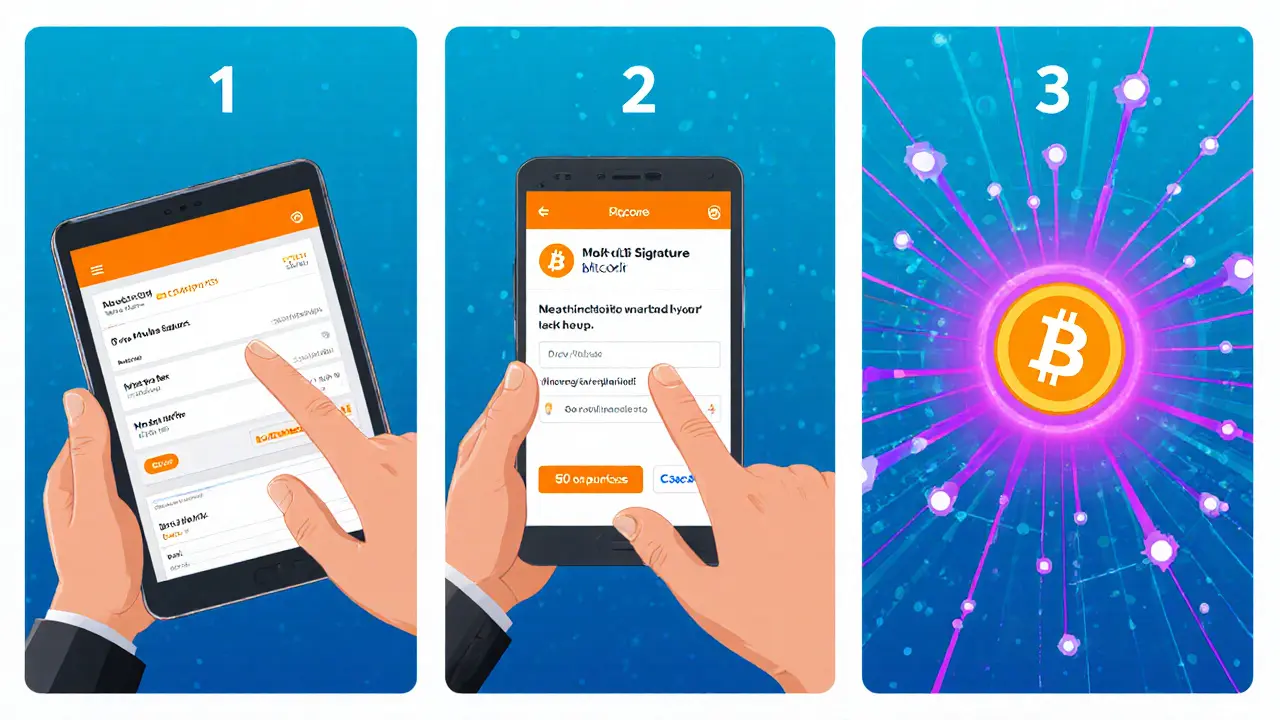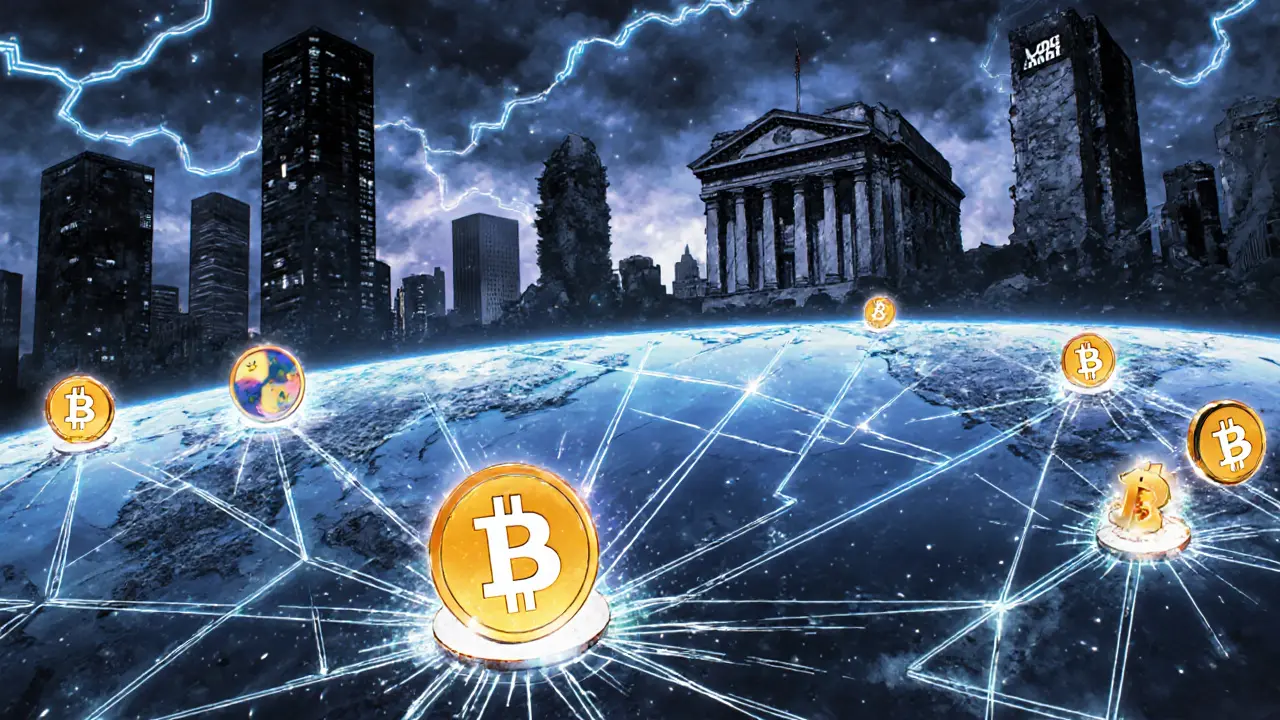P2P Crypto Platforms in Restricted Countries: Risks, Benefits, and Top Choices

P2P Crypto Platform Comparison Tool
Compare P2P Platforms for Restricted Markets
Find the best P2P platform for your country, payment method, and privacy needs.
Based on the article content, here's how the major P2P platforms compare:
| Platform | Escrow Type | KYC Approach | Key Payment Methods | Fee Range |
|---|---|---|---|---|
| Paxful | 2-of-3 multi-signature | Risk-based, tiered KYC | Bank transfer, mobile money, gift cards, cash deposit | 0.5-1.0% |
| LocalBitcoins | 2-of-2 escrow | Basic ID verification | Bank transfer, cash, PayPal | 1.0-1.5% |
| Binance P2P | Automated smart-contract escrow | Full KYC for all users | Bank transfer, mobile money, Alipay | 0.0% (trading fee) |
| Bisq | Fully non-custodial, no escrow | No KYC | Bank transfer, cash, crypto-to-crypto | 0.3-0.5% (mining fee) |
When traditional exchanges are blocked, peer-to-peer cryptocurrency platforms become essential for people who still want to move digital money. These services let you trade directly with another user, sidestepping banks, regulators, and sometimes even the internet filters that governments use to shut down crypto activity.
Key Takeaways
- In more than 18 countries, crypto exchanges are restricted or banned, creating a huge market for P2P platforms.
- Major players like Paxful, Binance P2P, LocalBitcoins, and Bisq each use different escrow and KYC models to stay operational.
- Benefits include financial inclusion, cheap cross‑border remittances, and a hedge against hyperinflation; drawbacks are higher fraud rates, liquidity gaps, and legal uncertainty.
- Compliance frameworks are complex - platforms often juggle 14‑17 separate regulatory regimes to stay afloat.
- Future growth is projected to exceed $210billion annually by 2025 despite tightening rules.
How P2P Crypto Platforms Bypass Restrictions
Unlike centralized exchanges that hold users’ funds in custodial wallets, P2P services employ a non‑custodial model. A typical trade works like this:
- Seller lists an offer (e.g., "sell 0.5BTC for 1,200USD").
- Buyer selects the offer and initiates a payment using a local method - bank transfer, mobile money, or even a gift‑card code.
- The platform places the crypto in a multi‑signature escrow (usually 2‑of‑3 signatures).
- After the seller confirms receipt of fiat, the escrow releases the crypto to the buyer.
This flow avoids the need for a local bank to process crypto directly, which is why it works in places where central banks have banned crypto‑related activities. The escrow protects both sides, and the platform’s risk‑based compliance engine monitors transactions for money‑laundering patterns that could attract regulator attention.
Leading Platforms Used in Restricted Jurisdictions
Below is a snapshot of the most widely adopted services in countries with crypto bans or heavy restrictions.
| Platform | Escrow Type | KYC/AML Approach | Supported Local Payment Methods (typical) | Average Fee |
|---|---|---|---|---|
| Paxful | 2‑of‑3 multi‑signature | Risk‑based, tiered KYC; higher tier for large trades | Bank transfer, mobile money, gift cards, cash deposit | 0.5‑1.0% |
| LocalBitcoins | 2‑of‑2 escrow (seller & buyer signatures) | Basic ID verification; stricter KYC after 2020 ban waves | Bank transfer, cash‑in‑person, PayPal (where allowed) | 1.0‑1.5% |
| Binance P2P | Automated smart‑contract escrow | Full KYC for all users; AML monitoring via AI | Bank transfer, mobile money, Alipay, WeChat Pay | 0.0% (trading fee), small network fee |
| Bisq | Fully non‑custodial, no escrow (atomic swap) | No KYC; reputation system and security deposits | Bank transfer, cash, crypto‑to‑crypto only | 0.3‑0.5% (mining fee) |
These four cover around 85% of P2P volume in banned markets according to Chainalysis Q22023 data. Each platform has a different risk profile, which matters when you’re dealing with governments that monitor internet traffic.

Pros and Cons for Users in Banned Countries
Benefits
- Financial inclusion: In Nigeria, 87% of P2P users were previously unbanked, allowing them to store value in crypto instead of cash.
- Inflation hedge: Venezuelan traders moved an average of $127million each month during 2022 hyperinflation, preserving purchasing power.
- Cheaper remittances: Traditional corridors charge 6‑7% fee; P2P routes often dip below 2%.
Drawbacks
- Higher fraud risk: Dr. Garrick Hileman notes a 43% higher fraud rate in restricted markets compared with regulated ones.
- Liquidity gaps: Average order‑book depth is roughly $8,500 versus $215,000 in open markets, leading to slippage on large trades.
- Legal vulnerability: 22% of Nigerian users reported account freezes by banks in 2023, and in Bangladesh users face potential criminal prosecution for using crypto at all.
Compliance, Security, and Legal Risks
The Financial Action Task Force (FATF) introduced Recommendation16, which pushes a “travel rule” for crypto transactions over $1,000. Enforcement is uneven, but platforms operating in restricted regions often adopt stricter internal AML measures to avoid sanctions. For example, Paxful evaluates each jurisdiction on three axes: regulatory restrictions, financial‑crime risk, and political stability.
Security models differ dramatically. Bisq’s fully non‑custodial design eliminates platform‑level theft but relies on users to manage private keys correctly. Paxful and Binance P2P use escrow contracts that can be frozen if the platform suspects illicit activity, which can lead to temporary loss of funds. A 2022 Chainalysis user survey found 37% of fraud cases originated from restricted jurisdictions, highlighting the need for thorough counter‑party vetting.
Legal exposure varies by country. China, Algeria, and Egypt enforce total bans, meaning any crypto‑related activity-P2P included-can lead to fines or imprisonment. Conversely, India permits crypto trading but imposes a 30% tax, so users must be prepared for tax reporting even if they transact via P2P.

Tips for Safely Using P2P Platforms in High‑Risk Regions
- Secure your wallet first. Use a hardware wallet or a reputable non‑custodial app with a strong PIN and backup seed phrase.
- Check the seller’s reputation. Look for at least 5 positive reviews, a high completion rate, and a verified identity badge.
- Prefer escrow‑protected trades. Avoid “direct send” offers that skip the platform’s escrow, as they eliminate recourse if something goes wrong.
- Use low‑risk payment methods. Bank transfers and mobile‑money payments rank lower on fraud risk than gift‑card codes.
- Stay updated on local regulations. Governments can change rules quickly; follow official central‑bank statements or reputable news sources.
- Keep records. Save screenshots of the trade, payment confirmations, and escrow release messages for potential tax or legal queries.
Following these steps can shave the average transaction time from 18minutes down to 12minutes while keeping your funds safe.
Future Outlook and Market Trends
Despite crackdown efforts, the P2P market is exploding. Chainalysis reported a 217% YoY growth in 2022, hitting $128billion in annual volume. Bloomberg Economics projects $210billion by 2025, driven by six of the top ten volume countries facing inflation above 50%.
Two forces will shape the next wave:
- Regulatory convergence. FATF’s push for universal travel‑rule compliance will force platforms to adopt real‑name verification even in jurisdictions where anonymity is prized. This may push privacy‑focused users toward fully decentralized alternatives like Bisq or HodlHodl.
- Technological adaptation. Platforms are already distributing APK files outside Google Play, integrating Tor for traffic obfuscation, and deploying AI‑driven fraud detection. Expect more “light‑client” web apps that run on 2G connections, expanding reach into rural Africa and Southeast Asia.
World Bank pilots in Zimbabwe demonstrate that P2P crypto can cut remittance fees from 6.5% to 1.2%, reinforcing the argument that these services are not just a workaround but a genuine financial innovation.
Frequently Asked Questions
Are P2P crypto platforms legal in countries where exchanges are banned?
Legality varies. In total‑ban regimes (e.g., China, Algeria) any crypto activity can be penalized, while in partially restricted markets (e.g., Nigeria, India) P2P trading is tolerated but may attract tax or reporting obligations.
How does escrow protect me on a P2P trade?
The platform holds the crypto in a multi‑signature address until the seller confirms receipt of fiat. If the seller never confirms, the escrow can be released back to the buyer, preventing loss of funds.
Which P2P platform offers the lowest fees for small transactions?
Binance P2P charges 0% trading fees for most fiat‑to‑crypto pairs, making it the cheapest option for transactions under $500, provided you complete the mandatory KYC.
Can I use a P2P platform without a bank account?
Yes. Many platforms support cash‑in‑person, mobile‑money, or gift‑card payments, which let unbanked users trade without a traditional bank.
What should I do if a trade gets frozen by the platform?
Contact the platform’s support channel immediately, provide all transaction receipts, and be prepared for a verification delay. Platforms like Paxful offer 24/7 live chat in multiple languages for faster resolution.

Hari Chamlagai
September 4, 2025 AT 21:03When you read a post that recycles the same stats from chainalysis without any nuance, you should ask why the author assumes that every user in a restricted market is a savvy trader. The reality is that most newcomers are barely literate about private keys, yet the article treats them as if they already understand multi‑signature escrow. Moreover, the claim that “P2P platforms will explode to $210 billion by 2025” ignores the fact that many governments are already drafting blanket bans that could cripple liquidity overnight. If you want to “financially include” the unbanked, you must first address education, not just hype. So, before you applaud the growth numbers, remember that the underlying risk profile is still dangerously high.
Ben Johnson
September 16, 2025 AT 10:49Sure, because “zero fees” instantly solves every user’s problem, right?
Jason Clark
September 28, 2025 AT 00:36The distinction between “non‑custodial” and “escrow‑protected” trades is more than a marketing buzzword; it defines the entire risk surface for participants.
On platforms like Binance P2P, the escrow is an automated smart‑contract that releases funds only after a cryptographically signed confirmation from the seller, which dramatically reduces the need for trust.
However, that same automation becomes a single point of failure when the platform’s AML engine flags a transaction and freezes the escrow pending review.
In contrast, Bisq’s atomic swap eliminates any custodial intermediary, forcing both parties to hold private keys throughout the exchange.
The downside of that model is the increased responsibility placed on the user to correctly verify transaction hashes, a step many novices skip.
When you add local payment methods such as mobile‑money or cash‑in‑person, you layer a second vector of fraud that is largely invisible to the blockchain.
Studies cited by the Financial Action Task Force show that payment‑method fraud in restricted jurisdictions is roughly 43 % higher than in open markets, a figure that aligns with the article’s fraud‑rate statistic.
The article’s table neatly summarizes fee structures, yet it omits the hidden cost of network fees and potential price slippage on low‑liquidity order books.
For example, a $500 trade on LocalBitcoins may incur a 1 % fee, but the effective cost could rise to 2 % once you factor in a typical $10 Bitcoin network fee and a 0.5 % price impact.
Users in hyper‑inflationary economies like Venezuela often accept these hidden costs because the alternative-holding cash that loses value by the minute-is far worse.
Regulatory pressure is also evolving; the FATF travel‑rule is being enforced unevenly, but platforms that pre‑emptively adopt full‑name verification are already seeing reduced transaction latency.
That pre‑emptive compliance, however, undermines the anonymity that many users in banned jurisdictions rely on, pushing them toward decentralized alternatives.
The article correctly notes that “technology adaptation” includes Tor‑enabled APKs, yet it fails to discuss the bandwidth limitations that can cause trades to time out on 2G connections.
In practice, a trader who cannot maintain a stable connection will see the escrow timeout, losing both time and potentially the trade entirely.
Ultimately, the choice of platform boils down to a trade‑off between convenience, cost, and the level of personal technical competence you are willing to develop.
Scott G
October 9, 2025 AT 14:23It is incumbent upon analysts to recognize that the regulatory heterogeneity across jurisdictions imposes a non‑trivial compliance burden on peer‑to‑peer operators. The article correctly identifies fourteen to seventeen distinct regimes as a source of operational complexity, yet a more granular examination of the underlying legal texts would be beneficial. Moreover, the assertion that “financial inclusion” is automatically achieved through P2P platforms disregards the digital literacy gap prevalent in many emerging economies. A prudent approach would therefore combine robust user education initiatives with the escrow mechanisms described. In summation, while the growth figures are impressive, they must be tempered by an awareness of the systemic vulnerabilities outlined herein.
VEL MURUGAN
October 21, 2025 AT 04:09Let’s cut through the hype: most users treat these platforms as a get‑rich‑quick scheme and ignore the fact that escrow can be hijacked the moment a regulator knocks on the door. The so‑called “zero‑fee” claim on Binance P2P is a misdirection; you still pay network fees and risk account freezes if you skip the KYC steps. While the table praises Paxful’s tiered KYC as a safety net, in practice it creates a funnel where high‑volume traders are the only ones who get decent protection. If you’re not prepared to vet counterparties with at least five positive reviews, you’re practically signing up for a loss. Bottom line: the platforms are useful, but only for the disciplined-and the naive will pay the price.
EDMOND FAILL
November 1, 2025 AT 17:56Honestly, the biggest tip I can give is to keep your seed phrase offline and never, ever share screenshots of your wallet with anyone on Telegram. The escrow is only as good as the platform’s customer support, and some of those bots take forever to reply. Also, when you’re dealing with cash‑in‑person trades, make sure you meet in a public place-don’t be that guy who trades in a dark alley because it looks “cool”. Lastly, don’t forget to double‑check the bank account details; a typo can turn a $200 deal into a $200 loss.
Luke L
November 13, 2025 AT 07:43What the article fails to mention is that many of these “global” P2P services are secretly dominated by western investors who want to keep their fingers on the pulse of emerging markets. The so‑called “decentralization” is a myth when a handful of servers in the US control the escrow logic and can shut down any trade that doesn’t fit their political agenda. If you truly want financial sovereignty, you need to look beyond Binance and Paxful and support home‑grown, community‑run nodes that aren’t beholden to foreign sanctions. Anything less is just another form of economic colonization dressed up in blockchain jargon.
Cynthia Chiang
November 24, 2025 AT 21:29Hey folks, just wanted to add that even if you’re new to crypto, the learning curve isn’t as steep as it looks-just start with a small amount and practice the escrow steps a few times. Also, don’t be afraid to ask for help in the community forums; most users are happy to share their eXperience and point out common pitfalls. Remember to keep a backup of your seed phrase in a safe place, preferably offline, so you don’t lose access if your phone dies. And yes, those fees can add up, but comparing them to traditional remittance costs shows you’re actually saving money in the long run. Stay safe out there and happy trading!
John Beaver
December 6, 2025 AT 11:16Quick heads‑up: when you’re using LocalBitcoins, make sure the seller’s “verified” badge isn’t just a fake pic-check the trade history and look for at least 10 completed deals. Also, don’t ignore the tiny “network fee” that shows up in the UI; it’s usually a few bucks but can surprise you on low‑value trades. If you’re trading on mobile data, keep an eye on the connection because the escrow will time out after 15 minutes of inactivity. Lastly, keep your app updated; older versions sometimes mishandle the multi‑sig escrow and can lock your funds.